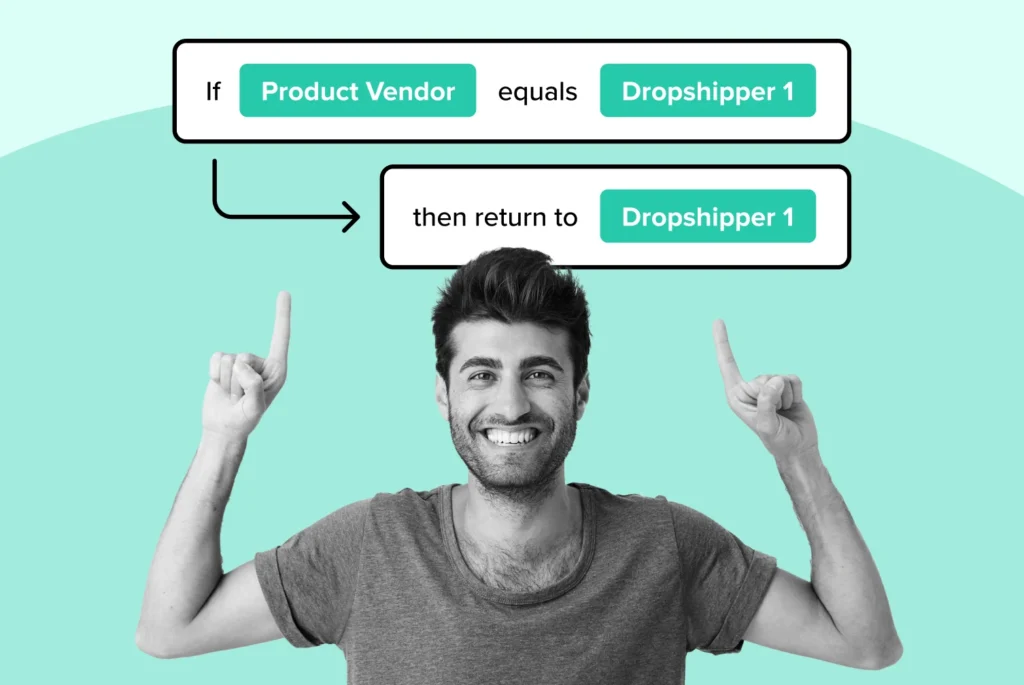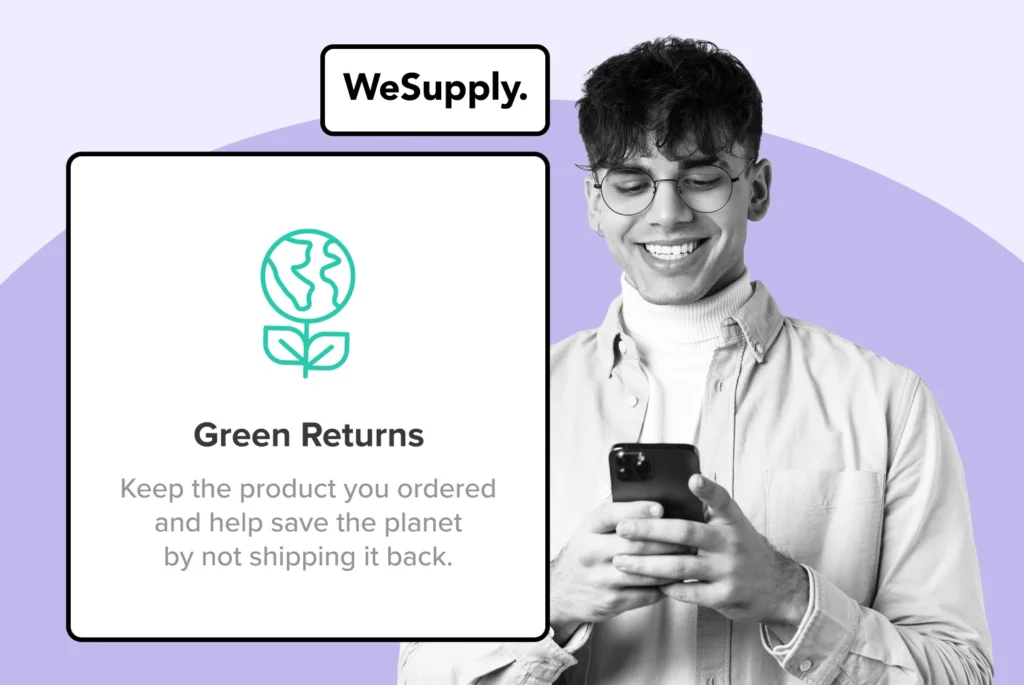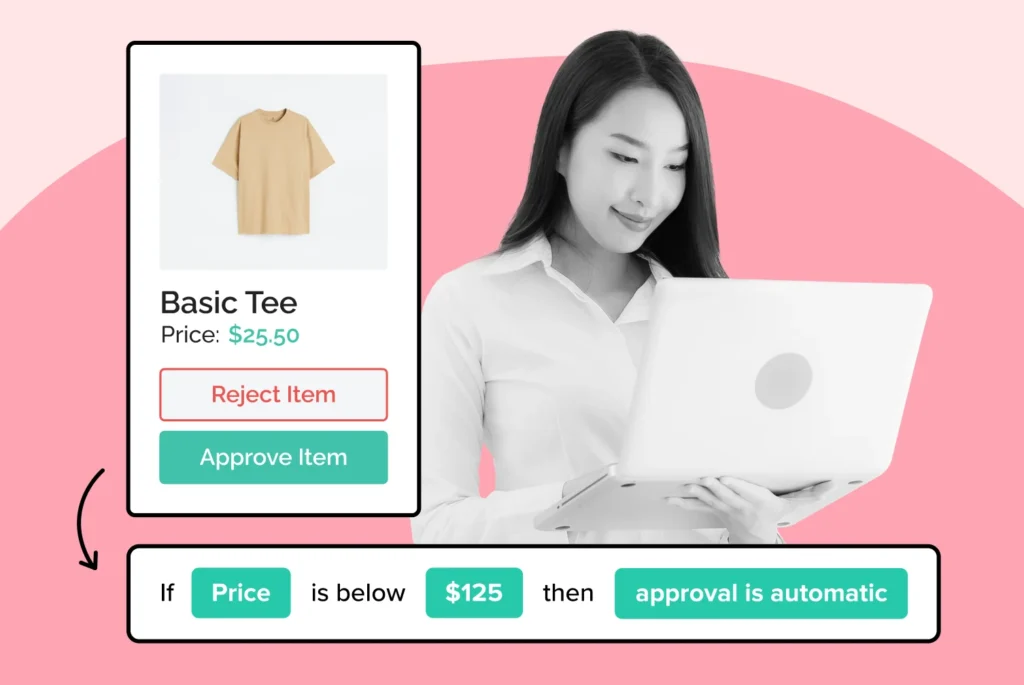
Best Practices for Sustainable eCommerce: Boost Your Store’s Sustainability
How to marry profitability with responsibility: From choosing eco-friendly packaging to implementing low-carbon shipping methods.
Boost customer experience and reduce support tickets
Realtime order and shipment tracking
Proactive order and shipping notifications
Predictive pre-purchase estimated delivery dates
Self-Serivce branded order tracking
Effortless experience delivered
Make returns profitable and delight customers
Flexibility to define any return destinations & conditions
Simplify returns for your customers and team
Incentivize exchanges over returns
Returns management made easy for your team
Understand why your customers are returning
Unify the online and the in-store experience
Hassle-free pickup experience for customers
In-Store Dashboard to keep operations streamlined
In-Store and Online orders unified
Drive foot-traffic to your stores
Boost customer experience and reduce support tickets
Realtime order and shipment tracking
Proactive order and shipping notifications
Predictive pre-purchase estimated delivery dates
Self-Serivce branded order tracking
Effortless experience delivered
Make returns profitable and delight customers
Flexibility to define any return destinations & conditions
Simplify returns for your customers and team
Incentivize exchanges over returns
Returns management made easy for your team
Understand why your customers are returning
Unify the online and the in-store experience
Hassle-free pickup experience for customers
In-Store Dashboard to keep operations streamlined
In-Store and Online orders unified
Drive foot-traffic to your stores
Find the answer to all your questions
Explore the most comon questions about WeSupply
Calculate the ROI that WeSupply can bring you
Request a no strings attached review of your current shopping experience and missed conversion opportunities
Take a step by step trip through our functionality to see how we can improve your ecommerce processes.
Read actionable articles on how to optimize your post-purchase experience and decrease support tickets
Get inspired by stories of how our customers implemented an effortless post-purchase experience
A Deep Dive into Top Companies' Order Tracking & Returns Strategy
Wondering if WeSupply is a good fit for you? Read through our use cases to see how we can help you increase conversion & improve CX!

The unsustainable world of returns in e-commerce presents a growing concern, with environmental and financial repercussions that are impossible to ignore. Understanding the full scope of this issue is the first step toward a viable solution. Herein, we’ll examine the underlying factors of return trends and identify sustainable practices crucial for the future of retail.
The handling of returns, particularly from online shopping, poses financial losses and environmental damage, with initiatives like charging for returns, utilizing virtual fitting technologies, and focusing on reselling or recycling being adopted to address these issues.
Return behaviors, such as bracketing and wardrobing in the fashion industry and disposal of consumer electronics, significantly contribute to environmental waste and CO2 emissions, with the need for better product information, incentivizing customers to keep items, and employing e-cycling practices for electronics.
Technological advancements such as AI, AR, and virtual fitting rooms are key to reshaping the future of sustainable e-commerce, reducing return rates and optimizing reverse logistics while also fostering consumer adoption of responsible shopping habits.
WeSupply revolutionizes returns with sustainability and customer focus, featuring instant store credit, flexible policies, branded portals, self-service options, and eco-friendly dispositions. It reduces return rates with insightful analytics, QR code labels, efficient tracking, and post-purchase notifications, all seamlessly integrated. Elevate your returns process—Get Started with WeSupply for a greener, more customer-friendly approach.
The problem of returns extends beyond the loss of sales. It’s not just about the money, but the environmental cost and the toll it takes on the planet as well. The current system of handling returns is unsustainable, and companies are beginning to realize the urgent need for change.
Let’s delve deeper into the impact of shopping online habits and the hidden cost of convenience.
The rise of e-commerce has led to a surge in online returns, with customers often buying multiple sizes or variations with the intention to return the unwanted items. The ease of returning products, especially with free returns policies, has encouraged this behavior, leading to an alarming rate of returns. At least 30% to 50% of clothing bought online is returned, signifying a high level of uncertainty and dissatisfaction among consumers.
This epidemic of returns cost the U.S. retail industry a staggering $816 billion in lost revenue in a single year, accounting for 16.5% of purchases.
But the cost of returns is not just financial. There’s an environmental cost too. Every year, up to 9.5 billion pounds of returned items end up in landfills, significantly contributing to environmental waste. This is a major issue, particularly in the fashion industry, as even items in perfect condition may be discarded due to being out of season or the cost of restocking being higher than disposal. Moreover, e-commerce returns account for 24 million metric tons of CO2 emissions worldwide annually, equivalent to the emissions from 5.1 million cars over a year.
Various strategies are being adopted to tackle this issue. Some of these strategies include:
Retailers charging for returns
Enhancing product information
Introducing virtual fitting room technologies
Focusing on reselling, donating, or recycling returned clothes rather than landfilling them
This shift in perspective from seeing returns as an unavoidable cost to an expense to be managed is crucial in the quest for sustainability and generating revenue whilst doing so.
WeSupply’s platform ingeniously mitigates the financial impact of product returns, a common challenge for e-commerce businesses. By streamlining the returns process, it not only enhances customer satisfaction but also significantly boosts the return on investment (ROI) for retailers. With its proactive communication tools and an efficient management system, WeSupply reduces the costs and complexities associated with returns. This approach ensures businesses can retain more revenue and reinvest it in growth strategies. To understand the potential financial benefits for your business, explore WeSupply’s ROI calculator.
The normalization of online returns is pushing us towards a sustainability crisis. On average, customers return up to 30% of products bought online, leading to increased CO2 emissions and waste. This trend is largely driven by consumer behavior, particularly the practice of bracketing, which involves buying multiple sizes or colors to try with the intention of returning the excess.
This section will shed light on how consumer behavior in the fast fashion industry and the consumer electronics sector contribute to the growing issue of unsustainable returns.
In the fast fashion industry, seamless returns have spurred unsustainable consumer behaviors such as bracketing and wardrobing – buying an item, wearing it once, and then returning it. This has led to a staggering 40% of garments being returned. Adding to this challenge, a significant portion of returned clothing ends up in landfills, with up to 9.5 billion pounds of returned items being landfilled annually. This contributes to the 24 million metric tons of CO2 emissions globally, a direct result of e-commerce returns.
Yet, there are strategies to mitigate this environmental impact. Retailers can:
Provide better product information
Incentivize customers to keep items rather than return them
Ensure returned clothes are resold, donated, or recycled instead of landfilled.
Consumers, too, can play a part by optimizing in-store shopping at physical stores, purchasing only what they are sure to wear, and dropping off returns to minimize “last-mile” shipping emissions.
WeSupply plays a pivotal role in mitigating the environmental impact of the fast fashion industry by encouraging sustainable consumer practices and enhancing the efficiency of returns management. By incentivizing exchanges over returns, WeSupply not only helps save sales but also increases the average order value through the offer of instant store credit.
This approach rewards customers who opt for store credit over refunds and redirects them to the product catalog, fostering a more sustainable shopping cycle. Furthermore, its intelligent dispositions system ensures that returns are directed to suitable channels, such as recycling centers, thereby reducing waste and promoting environmental sustainability.
WeSupply also facilitates a seamless omnichannel experience with its Buy Online Pickup in Store and Buy Online Return in Store options, encouraging foot traffic and driving additional revenue, while supporting eco-friendly shopping behaviors.
Key Features:
Rewards customers for choosing instant store credit over refunds, sending them back to the product catalog after initiating a return.
Implements intelligent dispositions to direct returns to appropriate channels, like recycling centers, for a positive environmental impact.
Enables customers to pick up orders directly from the store, managing notifications for store pickups efficiently.
Drives additional revenue and foot traffic with the option for customers to return online purchases in store.
The issue of unsustainable returns isn’t exclusive to the fashion industry. It extends to the consumer electronics sector as well. Although electronics have a lower return rate of 7% compared to clothing, their disposal still contributes to the growing problem of e-waste.
Improper disposal of electronic waste in landfills leads to the release of toxic chemicals, affecting:
air
soil
water
human health
In response to this, proper e-cycling practices are crucial. Items can be recycled, refurbished, resold, or reused, instead of contributing to the growing stream of e-waste. Retailers must address this problem by creating more sustainable return policies for electronics and educating consumers on the environmental consequences of returns.
WeSupply offers a strategic solution to the complex challenge of managing online returns, which often goes unnoticed in the e-commerce sector. By providing businesses with the ability to create custom return policies, WeSupply puts control back in the hands of retailers. This flexibility allows for nuanced management of returns, including policies for final sale items, return window lengths, and the approval process for return requests. Furthermore, customization can be tailored to specific countries or regions, product types, return reasons, resolution types, and order tags. This level of customization not only streamlines the returns process but also enhances customer satisfaction by providing clear, tailored return policies that meet the diverse needs of consumers across different markets.
The environmental impact of e-commerce returns is immense. With every return, there’s an increase in emissions and energy consumption due to additional transportation stages, and a potential addition to landfill waste if the returned items are not resold.
In the following sections, we’ll delve into the dire consequences of high return rates in e-commerce and the journey of returned merchandise towards sustainability.
The high return rates in e-commerce, especially in the fashion industry, lead to a cycle of increased global carbon emissions and greenhouse gas emissions from transportation, packaging, and potential waste in landfills. About one in four returned goods is landfilled, with clothing potentially having an even higher landfill rate due to seasonality or the cost of restocking.
However, there are actions we can take to mitigate this. Retailers can reduce packaging impact and increase sustainability by:
using renewable materials
granting longer return windows to combine multiple returns
encouraging customers to drop off returns at brick-and-mortar locations.
Consumers, on the other hand, can contribute by making more informed purchasing decisions, thus reducing the flow of returned clothing to landfills.
WeSupply addresses the critical issue of high return rates in e-commerce, particularly within the fashion industry, by implementing strategic features aimed at reducing waste and enhancing customer satisfaction. Offering an extended holiday return window, WeSupply caters to the increased demand for flexibility during peak shopping seasons, improving the overall shopping experience. By allowing retailers to set brand or vendor-specific return windows, WeSupply provides the necessary flexibility to manage returns effectively while maintaining control. Additionally, encouraging exchanges even after the return window has expired fosters customer loyalty and reduces waste associated with returns. The option to buy online and return in-store further supports this by driving foot traffic and additional revenue, presenting a sustainable alternative to traditional return processes.
Key Features:
Brand/vendor specific return windows for tailored flexibility and control over the return process.
Allowance for exchanges after the return window expires to foster customer loyalty and provide added flexibility.
Buy Online Return in Store option to drive additional revenue growth and increase foot traffic, offering a sustainable return solution.
When it comes to returned merchandise, the journey doesn’t have to end at a landfill. Innovative strategies can make this journey more sustainable, reducing the environmental impact. For instance, consolidating returned items and optimizing reverse logistics, such as route planning and using electric vehicles, can lower emissions associated with the journey of returned merchandise. Furthermore, implementing eco-friendly returns management practices, like using recyclable packaging and promoting product recycling, can enhance sustainability efforts.
Moreover, technology can play a crucial role in making the journey of returned merchandise more sustainable. Leveraging technology and data analytics can improve the efficiency of reverse logistics, helping to make the journey of returned merchandise more sustainable. By adopting an approach that prioritizes sustainability, retailers can transform the journey of returned merchandise from a path to waste into a path towards a more sustainable future.
WeSupply stands at the forefront of sustainability in e-commerce by tackling the complex journey of returned merchandise with innovative solutions. Its intelligent dispositions feature directs returns to appropriate channels, such as recycling centers, which significantly contributes to environmental sustainability by minimizing waste. Additionally, WeSupply’s returns analytics provide invaluable insights into return patterns, allowing businesses to identify the most returned products, understand the reasons behind these returns, and pinpoint serial returners. This data-driven approach enables companies to reduce their return rates through actionable insights, fostering a more sustainable e-commerce ecosystem. Furthermore, order flow logistics analytics offer a comprehensive understanding of the order management process, highlighting areas for improvement in the post-purchase experience and optimizing logistics from the moment an order is placed until it reaches the customer.
Key Features:
Returns Analytics for eCommerce Business
Book a quick call with our experts to see how WeSupply can help you understand why your customers are returning: Identify the most returned products; Understand why those products are returned; Identify which customers are serial returners; Reduce Return Rate with Actionable Insights.
Taking center stage in the returns dilemma, the fashion industry has a significant role to play in changing the current unsustainable practices. High return rates, often due to size and fit issues, make fashion one of the sectors most affected by the returns epidemic.
In the next sections, we’ll explore innovative ways to reduce returns and waste, and how technology is reshaping retail returns.
One of the key strategies in reducing returns and waste in retail is addressing the issue of size and fit. Sizing errors account for a significant portion of returns, particularly in the fashion industry. To tackle this, retailers are turning to technology, implementing tools such as sizing calculators and digital avatars to help consumers make the right purchase decisions the first time.
But it’s not just about size. Retailers are also exploring customer-centric returns solutions such as returnless refunds and incentivized retention. Such strategies not only reduce returns but also improve customer loyalty and lessen environmental burdens. The message is clear: addressing the returns epidemic requires a combination of innovative strategies, cutting-edge technology, and a relentless focus on the customer experience.
In the quest to reduce returns, technology is proving to be a game-changer. Take virtual fitting rooms, for instance. By employing augmented reality, these digital innovations allow customers to “try on” apparel before buying, thus addressing sizing issues and significantly reducing return rates. The integration of such technology in online retail platforms can lead to a reduction of up to 40% in the cost of return handling.
Moreover, technology can also help streamline reverse logistics. AI-driven returns management software can make the process of handling returns more efficient, reducing wasteful touchpoints and the environmental impact.
As we move forward, technology will continue to reshape retail returns, making it more sustainable and efficient.
As we’ve seen, the cost of returns is not just financial. It’s also about the environmental cost, the waste of resources, and the missed opportunities for sales.
So, how can we reduce refunds and unwanted items in e-commerce? Let’s delve into some strategies that can help us achieve this.
The return process is just as important as the purchase process. Enhancing this process through technology and personalization can significantly reduce returns. Tools like virtual fitting rooms and size guides can help consumers make more accurate purchase decisions. Additionally, implementing customer service channels like live chat or instant messaging can quickly resolve product issues and reduce unnecessary returns.
Email automation provides detailed product information and facilitates order changes, leading to fewer mistaken returns. Furthermore, augmented reality (AR) can be integrated into e-commerce platforms, allowing shoppers to visualize products in their own space. This not only enhances the shopping experience but also reduces the likelihood of returns, as customers get a better sense of the product before purchase.
WeSupply streamlines the returns process by leveraging technology and personalization to enhance both retailer efficiency and customer satisfaction. This platform offers instant store credit to encourage exchanges, reducing overall return rates. It features a branded returns portal that reinforces customer loyalty and a self-service returns process for effortless customer experiences. Additionally, WeSupply allows for flexible returns rules, catering to various use cases and simplifying the process with autogenerated QR code return labels. Its efficient returns tracking system and the ability to send post-purchase email & SMS notifications keep customers informed and engaged. The “Buy Online, Return In Store” option merges the convenience of online shopping with the immediacy of in-store returns. Lastly, WeSupply’s ability to integrate with numerous third-party tools ensures a seamless operational flow.
Key Features:
Branded returns portal for a seamless brand experience.
Self-service returns process for customer convenience.
Flexible returns rules to accommodate various scenarios.
Efficient returns tracking for customer transparency.
Post-purchase email & SMS notifications to keep customers engaged.
“Buy Online, Return In Store” for added shopping convenience.
Broad third-party integrations for seamless operations.
WeSupply’s innovative features offer an unparalleled returns management solution that not only simplifies the process but also elevates the customer experience, making it an essential tool for any retailer looking to improve sustainability and customer satisfaction. Ready to transform your returns process and delight your customers? Book a demo with WeSupply today and see the difference for yourself.
Just like in the case of Evereve, a fashion retailer with over 93 boutiques and a significant online presence faced challenges with a manual and cumbersome returns process that lacked visibility and efficiency. By partnering with WeSupply, Evereve transformed its returns strategy through automation, integrating solutions like Magento, Zendesk, Celerant, and Veeqo into a unified system. This strategic overhaul focused on proactivity, self-service, and return flexibility, leading to cost savings, reduced support tickets, faster returns processing, and a streamlined customer experience. Evereve leveraged WeSupply’s capabilities to enhance customer satisfaction and loyalty by enabling self-service returns, ultimately improving operational efficiency and employee productivity.
Discover how Evereve turned challenges into opportunities with WeSupply. Read the full case study and explore how to transform your returns process into a competitive advantage.
Combat inconvenience with proactivity & self service
Book a quick call with our experts to see how WeSupply can help you make returns easy for your customers with a beautiful, self-service solution that makes their experience easier while also providing new ways to lower costs and earn back revenue.
Artificial Intelligence (AI) and technology play a crucial role in reducing clothing waste. Advanced fitting tools, powered by AI, can significantly reduce size-related clothing returns. In addition, analyzing return patterns using AI can help identify problem returners and develop strategies to address return abuse, ultimately reducing clothing waste.
Moreover, Augmented Reality (AR) can help customers in the following ways:
Choose the correct size or fit, reducing or eliminating the need for clothing returns
Provide a realistic visualization of clothing items on a person’s own body
Expect fewer returns, thus diminishing the environmental impact of clothing waste.
Promoting responsible shopping habits is vital in addressing the returns epidemic. As consumers, our shopping behaviors significantly impact the sustainability of e-commerce. Let’s explore how we can encourage more responsible shopping and return practices and the benefits of sustainable return policies.
As consumers, we play a significant role in driving sustainability in e-commerce. Our attitudes towards sustainability have become increasingly important in our shopping decisions, especially since the COVID-19 pandemic. By adopting sustainable behaviors like recycling and making more informed purchase decisions, we can reduce the flow of returned items to landfills.
Companies can motivate us to waste less by making the process of product transformation into new items more salient, such as highlighting the recycling of materials into new products. As consumers, we can also influence our peers to adopt sustainable practices. Social influence is a powerful tool in promoting responsible shopping habits, as people are often swayed by their peer groups and mass media.
Sustainable return policies are a win-win for both consumers and retailers. For consumers, these policies provide an opportunity to contribute to sustainability while enjoying a hassle-free shopping experience. For retailers, sustainable return policies not only mitigate the environmental impact of returns but also enhance customer satisfaction and loyalty.
Companies that demonstrate a strong commitment to environmental and social sustainability can effectively encourage consumer participation in sustainable return practices. Moreover, the resale or recycling of returned items contributes to the circular economy, reducing waste and supporting more sustainable business models.
Ultimately, sustainable return policies are not just about mitigating the impact of returns. They’re about creating a sustainable future for e-commerce.
WeSupply’s flexible return rules embody the essence of sustainable return policies, creating a win-win scenario for both consumers and retailers. By allowing businesses to tailor their return policies with precision—such as adjusting return windows and conditions based on product type, region, or customer behavior—WeSupply not only enhances customer satisfaction by meeting their specific needs but also significantly reduces the environmental impact of returns. This approach minimizes unnecessary logistics and waste, encouraging a more conscientious consumption pattern. For retailers, it translates into cost savings, reduced carbon footprint, and a stronger brand loyalty built on the principles of sustainability and customer-centricity. WeSupply’s innovative platform thus plays a pivotal role in promoting environmental responsibility while ensuring business growth and consumer contentment.
Looking forward, the future of e-commerce hinges on sustainability. As the returns dilemma continues to challenge the industry, it’s clear that a shift is needed. A shift towards a more circular model in reverse supply chain management, where returned or overstock merchandise is resold as much as possible.
Let’s delve into how we can rethink retail for a more sustainable and efficient future and the impact of consumer behavior and technology on e-commerce sustainability.
The return revolution in retail is about rethinking our practices for a more sustainable future. It’s about using innovative return management solutions, such as refurbishment strategies, to keep returned items in circulation longer. Additionally, advanced technologies like AI can streamline reverse supply chain logistics, leading to fewer wasteful touchpoints and reducing environmental impact.
Making the returns process more sustainable is not just about reducing waste. It’s also about improving the customer experience. Fast refunds, incentives for retention, and personalized return experiences can significantly reduce returns while enhancing customer loyalty.
The return revolution is not just about reducing returns. It’s about transforming the way we approach retail for a more sustainable and efficient future.
Looking ahead, consumer behavior and technology have a significant impact on e-commerce sustainability. Consumers are becoming increasingly accepting of buying refurbished and pre-owned products on the secondary market, indicating a shift towards a more sustainable mindset. Meanwhile, technology, particularly AI and AR, is playing a crucial role in improving e-commerce sustainability by streamlining reverse logistics and reducing return rates.
However, the journey towards sustainable e-commerce is not without its challenges. The “attitude-behavior gap,” where consumers’ positive attitudes towards the environment do not align with their purchasing behavior, poses a significant hurdle. Nevertheless, with effective communication strategies, demographic considerations, and the use of green marketing strategies, we can overcome these challenges and pave the way for a more sustainable future for e-commerce.
In conclusion, the returns epidemic in e-commerce is a complex issue with financial and environmental implications. However, with a shift in consumer behavior and the integration of technology, a more sustainable future for e-commerce is within reach. As consumers, we need to adopt responsible shopping habits and make more informed purchase decisions. As retailers, we need to rethink our approach towards returns, implementing innovative strategies and technologies to make the returns process more sustainable and efficient. Together, we can turn the tide on the returns epidemic and pave the way for a more sustainable future for e-commerce.
WeSupply addresses the pressing returns dilemma by fostering environmental sustainability and enhancing customer satisfaction through a comprehensive suite of features. This platform decreases return rates and promotes sustainable practices by incentivizing exchanges over refunds, offering flexible return policies, and integrating options like Buy Online Pickup and Return in Store. Key innovations include intelligent dispositions for directing returns to recycling centers, analytics for pinpointing return trends, and logistics insights for improving the post-purchase experience. Features such as instant store credit, a branded returns portal, self-service returns, flexible policy rules, QR code labels for easy returns, efficient tracking, and post-purchase notifications all streamline the returns process. Moreover, WeSupply’s broad integration capabilities ensure seamless operations. By combining technology with personalization, WeSupply not only solves the returns challenge but also supports eco-friendly consumer habits and retailer growth.
Transform your returns process into an asset for both sustainability and customer loyalty. Get Started with WeSupply today and pave the way for a greener, more efficient retail future.
Free returns are considered bad because the transportation of returned products increases carbon emissions, contributing to environmental damage and climate change. This means that making a return can have negative effects on the environment.
Returns are detrimental to the environment due to the extra shipping, packaging, and emissions they generate. The rise of fast fashion has made clothing returns alone release emissions equal to 3 million cars in the US.
WeSupply targets environmental sustainability by directing returns to eco-friendly channels through intelligent dispositions. This reduces waste and supports recycling efforts.
Yes, by incentivizing exchanges over refunds with instant store credit and providing detailed analytics, WeSupply helps identify and reduce return rates, addressing one of the core issues of the returns dilemma.
Yes, its flexible returns rules can be tailored to match any use case, including specific scenarios for different product types, regions, or customer behaviors, providing a personalized approach to returns management.
Yes. WeSupply has an Official Shopify App. You can download it and start integrating with your Shopify Store.
Yes, WeSupply has an official extension for Magento. The WeSupply x Magento integration allows for automating order tracking experiences, reducing customer inquiries, automating shipping email and SMS notifications, and providing a fully branded order tracking experience
Yes, WeSupply has an official BigCommerce App. You can integrate WeSupply with your BigCommerce store to improve your post-purchase customer experience.

Learn How To Create Successful Post Purchase Email Campaigns
Build an effective post-purchase email flow that helps you increase customer satisfaction and drive revenue growth!

How to marry profitability with responsibility: From choosing eco-friendly packaging to implementing low-carbon shipping methods.

This article demystifies dropshipping, offers clear steps for getting started, and divulges expert tactics for thriving in online retail!

This guide distills the crucial mistakes that could be undermining your eCommerce success and equips you with the insights to avoid them!

This isn’t about reinventing the wheel: it’s about making smarter, evidence-based decisions that propel your eCommerce venture forward!

Discover practical, actionable advice for incorporating sustainable eCommerce into the core of holiday commerce practices!

The essential guide to making circular economy eCommerce returns practical and profitable, helping you step away from waste!

Insights on planning your return policy, adapting to customer needs, and ensuring your eCommerce footprint is as light as possible!

Vital sustainability metrics to track in eCommerce: from assessing carbon output to reducing packaging waste!

Environmental stakes are higher than ever: discover how your business can adapt its returns process to be part of a greener eCommerce future.